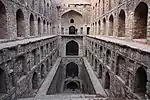Architecture of Delhi
The Architecture of Delhi dates back more than a thousand years. As the capital of several great empires of India, including Rajput kingdom, Delhi Sultanate, Mughal Empire, and British Raj, the city of Delhi has been a centre for art and architecture.
Rajput Kingdom
The few surviving structures from before the Delhi Sultanate period include Agrasen ki Baoli, Surajkund reservoir, Lal Kot and Qila Rai Pithora. There were several temples built during this period, remnants of which are still present in Qutb complex.
rajput is derived from the Hindi word "rajputra" meaning "the son of the ruler"
Delhi Sultanate
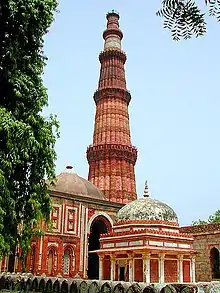 The Qutub Minar is the world's tallest brick minaret at 72.5 metres, built by Qutb-ud-din Aibak of the Slave dynasty in 1192 CE.[1]
The Qutub Minar is the world's tallest brick minaret at 72.5 metres, built by Qutb-ud-din Aibak of the Slave dynasty in 1192 CE.[1]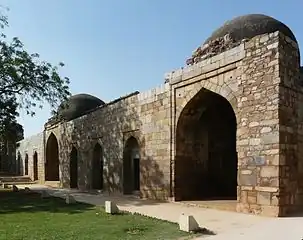 Alauddin Khilji's madrasa and Tomb in the Qutb complex.
Alauddin Khilji's madrasa and Tomb in the Qutb complex. Tomb of Ghiyasuddin Tughluq within the Tughlaqabad Fort.
Tomb of Ghiyasuddin Tughluq within the Tughlaqabad Fort. Jahaz Mahal is built during the Lodi dynasty period (1452–1526) as a pleasure resort.
Jahaz Mahal is built during the Lodi dynasty period (1452–1526) as a pleasure resort.
The Delhi Sultanate ruled the city between 1206 and 1526. Their rule saw the development of early Indo-Islamic architecture, the most prominent being the Qutb Minar complex, a group of monuments surrounding the Qutb Minar. This period also saw building of many forts and cities like Siri Fort, Tughlaqabad and Feroz Shah Kotla. Many tombs were built around this period which are still present in many locations like Qutb Minar complex, Hauz Khas Complex and Lodi Gardens.
Mughal Empire
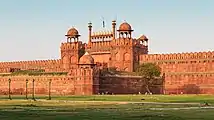 The Red Fort was commissioned by Mughal Emperor Shah Jahan in the 17th century, it was the main residence of the Mughal emperors for nearly 200 years.[2]
The Red Fort was commissioned by Mughal Emperor Shah Jahan in the 17th century, it was the main residence of the Mughal emperors for nearly 200 years.[2]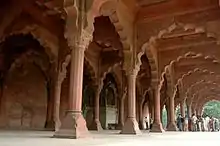
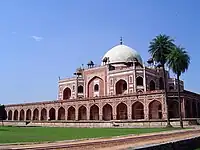
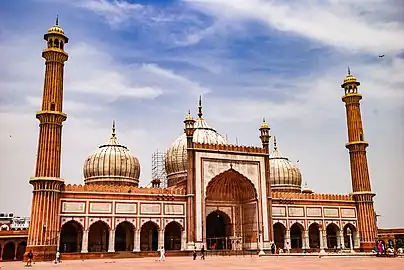 The Jama Masjid is one of the largest mosques in India.
The Jama Masjid is one of the largest mosques in India.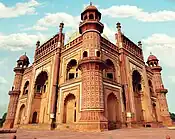
Mughal Architecture emerged as a form of Indo-Islamic architecture during the rule of the Mughal Empire. Mughal architecture is characterized by large bulbous onion domes, the use of white marble and red sandstone, delicate ornamentation work, and large buildings surrounded by gardens on all four sides.
The Humayun's Tomb is the first notable example of Mughal architecture in Delhi. Except for a few architectures like Humayun's Tomb and Purana Qila, most of the architectural work of this period was done in Shah Jahan's time or later. This period also saw building of 18th century Astronomical Observatory called Jantar Mantar.
Another important achievement of this period was building of Mughal gardens. Its design was inspired by Persian Char Bagh Gardens. Some gardens built during Mughal period are garden built in front of Humayun's Tomb, Roshanara Bagh, Qudsia Bagh and Garden built in Safdarjang's tomb complex.
British Colonial period
 St. James' Church was designed in the Renaissance Revival style and completed in 1836. It is situated on a cruciform plan and consists of neoclassical style porticoes, with a baroque dome in the center.
St. James' Church was designed in the Renaissance Revival style and completed in 1836. It is situated on a cruciform plan and consists of neoclassical style porticoes, with a baroque dome in the center. The India Gate is a triumphal arch and war memorial in the middle of New Delhi. It was designed by Edwin Lutyens and completed in 1921.
The India Gate is a triumphal arch and war memorial in the middle of New Delhi. It was designed by Edwin Lutyens and completed in 1921.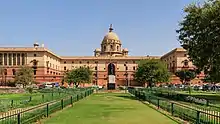 The Secretariat Building was designed by Herbert Baker and completed in 1927.
The Secretariat Building was designed by Herbert Baker and completed in 1927.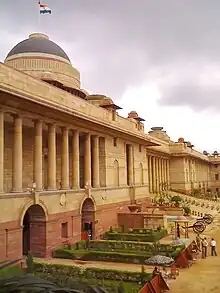 The Rashtrapati Bhawan was the residence of the British Viceroy, and now serves as the residence of the President of India. It was designed by Edwin Lutyens and completed in 1929.
The Rashtrapati Bhawan was the residence of the British Viceroy, and now serves as the residence of the President of India. It was designed by Edwin Lutyens and completed in 1929.
After Delhi was declared the site for a new capital of India, George V laid the foundation of New Delhi, which would serve as the capital. The British invited Edwin Lutyens and Herbert Baker to design the government buildings. This area would also be called Lutyens' Delhi in honor of the architect. Members of Lutyens' team of architects included Walter Sykes George, Arthur Gordon Shoosmith and Henry Medd. It is reported that Lutyens was reluctant to incorporate Indian features in his style, but later conceded.
Post-Independence
.jpg.webp) The Supreme Court of India was designed by Ganesh Bhikaji Deoalikar and completed in 1958. Its style was inspired by the Lutyens-Baker buildings.
The Supreme Court of India was designed by Ganesh Bhikaji Deoalikar and completed in 1958. Its style was inspired by the Lutyens-Baker buildings. The Hall of Nations, designed by Raj Rewal and completed in 1972 was regarded as one of the best examples of modernist architecture in India. It was demolished in 2017, despite several protests.
The Hall of Nations, designed by Raj Rewal and completed in 1972 was regarded as one of the best examples of modernist architecture in India. It was demolished in 2017, despite several protests. The New Delhi Municipal Council Building was designed in the brutalist style by Kuldip Singh, and completed in 1984.
The New Delhi Municipal Council Building was designed in the brutalist style by Kuldip Singh, and completed in 1984. The Lotus Temple was designed by Faribohrz Sahba and completed in 1986. Its design was inspired by the shape of a lotus.[4]
The Lotus Temple was designed by Faribohrz Sahba and completed in 1986. Its design was inspired by the shape of a lotus.[4]
The Supreme Court of India was designed by Ganesh Bhikaji Deolalikar in the same style as that of the other major buildings in Lutyens' Delhi. However, modernist architecture became prevalent in Delhi as well as all over India, especially after the influence of Le Corbusier.[5]
After Independence, the best examples of modern architecture in Delhi include IIT Delhi (1961) by Jugal Kishore Chodhury, Hall of Nations (1972) and Asian Games Village (1982) by Raj Rewal, Palika Kendra building (1984) by Kuldip Singh, and Lotus Temple (1986) by Fariborhz Sahba.
In 2017, the demolition of the Hall of Nations received worldwide condemnation from architectural enthusiasts. It was considered to be one of the best examples of modernist architecture in India.[6]
References
- "Qutb Minar and its Monuments, Delhi". UNESCO World Heritage Centre. Archived from the original on 27 April 2019. Retrieved 27 April 2019.
- "Red Fort Complex". UNESCO World Heritage Centre. Archived from the original on 2 April 2019. Retrieved 27 April 2019.
- "Humayun's Tomb, Delhi". UNESCO World Heritage Centre. Archived from the original on 4 July 2018. Retrieved 27 February 2019.
- Permanent Delegation of the Government of India to UNESCO. "Bahá'í House of Worship at New Delhi". UNESCO World Heritage Centre. Archived from the original on 26 August 2016. Retrieved 2 May 2019.
- Mukerji, Arjun; Sanghamitra, Basu. "A Search for Post-Modernism in Indian Architecture". Abacus. Retrieved 27 February 2019.
- Langar, Suneet Zishan (23 June 2017). "The Demolition of Delhi's Hall of Nations Reveals India's Broken Attitude to Architectural Heritage". ArchDaily. Retrieved 23 March 2019.
